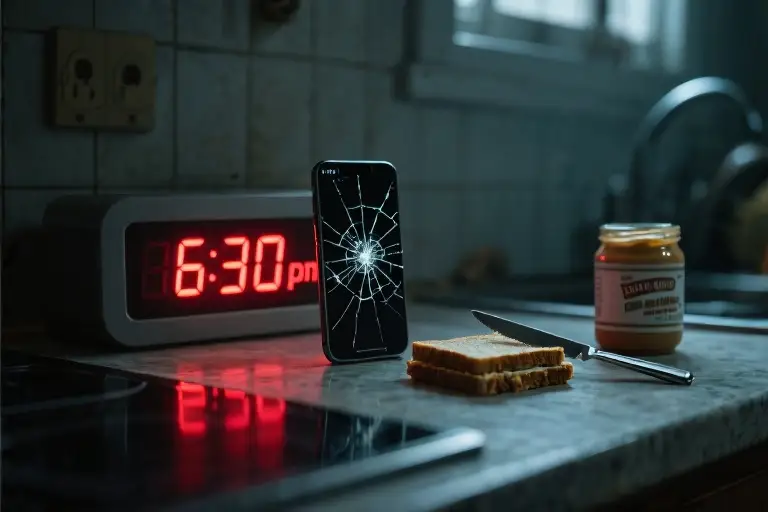The fluorescent lights buzzed like angry hornets overhead as my vision dissolved into static. At the ATM that day, the world didn’t fade—it snapped off like a switched channel. My fingers found my mother’s sleeve. ‘Mom, I can’t see you.’
Her shoulder jerked away before my hand fully connected. The dismissal traveled up my arm like an electric shock. Then the sounds disappeared—not gradually, but like someone had pressed mute on reality itself. ‘Mom, I can’t—’
‘Damn it!’ She whirled, eyes reflecting the ATM’s blue glow. ‘I don’t have time for your games.’ Those were the last words I heard before concrete rushed toward my face.
When consciousness returned, a stranger’s hands were guiding a water bottle to my lips while my mother’s patent heels clicked toward the exit. No questions. No concern. Just the squeak of rubber soles and a hissed command: ‘Get in the car.’
Twenty-three years later, that same metallic taste flooded my mouth when I heard my own voice bark at my child: ‘Get in here. NOW.’ The vibration in my vocal cords felt alien yet horribly familiar—like discovering you’ve been singing someone else’s lullaby in your sleep. My daughter’s flinch mirrored my childhood reflex so precisely it triggered a physical recoil.
This is how generational trauma operates—not as some abstract inheritance, but as literal muscle memory. The way your tongue automatically shapes certain phrases. How your hands move during arguments. The particular angle at which rage tilts your head. These aren’t choices; they’re biological post-it notes left by previous occupants of your nervous system.
Science confirms what survivors know instinctively. Childhood adversity physically alters the amygdala’s threat detection system and the prefrontal cortex’s braking mechanism. Essentially, we develop hair-trigger alarm systems with faulty off-switches. The real question isn’t why we sometimes become what we feared most, but how to install new wiring alongside the old.
That moment with my daughter—hearing my mother’s syntax in my mouth, seeing my childhood terror reflected in her widened eyes—became what therapists call a ‘breakthrough breakdown.’ Not because I handled it perfectly (I didn’t), but because I recognized the script mid-performance. Like catching yourself sleepwalking, that awareness creates the first fragile opening for change.
What follows isn’t a redemption arc. Healing from toxic parenting doesn’t follow movie logic where one epiphany erases decades of programming. It’s messier—a daily negotiation with the ghost in your synapses. Some days you’ll parent like the person you needed as a child. Other days, you’ll hear their words come out of your mouth and taste bile afterward. Both truths coexist.
The work lies in that space between trigger and response—the milliseconds where we can still choose which neural pathway to take. It’s there, in those liminal moments, that we begin rewriting the body’s code.
The Invisible Contracts We Signed
The fluorescent lights buzzed overhead as my fingers left greasy fingerprints on the fast-food wrapper. That chicken sandwich wasn’t nourishment – it was a muzzle. At twelve years old, I learned love came with invisible contracts written in disappearing ink. Now as an adult decoding my reactions, I recognize those unsigned agreements still influence how I parent.
Five Covert Contracts of Controlling Love
- The Vanishing Clause: Your needs disappear when inconvenient (“Fainting is only acceptable if no one notices”)
- The Apology Addendum: You must apologize for existing (“The worker’s pity was worse than Mom’s rage”)
- The Hunger Penalty: Physical needs equal betrayal (“The chicken sandwich wasn’t food. It was a muzzle”)
- The Perfection Rider: Be flawless by becoming invisible (“Invisible girls never leave crumbs”)
- The Voice Amendment: Her words eclipse yours (“Mine was a dial tone. Hers was gospel”)
These unconscious agreements wire themselves into our nervous systems. Research from the Journal of Child Psychology shows childhood emotional neglect physically alters the amygdala’s threat detection system. Like my body that day at the ATM – it kept the receipt long after the transaction ended.
The Neurobiology of Inherited Trauma
When parents use love as conditional currency, children’s developing brains adapt in measurable ways:
- Prefrontal cortex: Reduced activity in emotional regulation centers
- HPA axis: Hyperactive stress response systems
- Mirror neurons: Overdeveloped threat detection pathways
We don’t just remember trauma – we metabolize it. The marble dust of those sculpted childhoods settles in our bones. But here’s what neuroscience confirms: neural pathways can be rebuilt. Every time we:
- Notice the old contracts (“I just heard her tone in my voice”)
- Renegotiate terms (“My child can pick mismatched clothes”)
- Create new agreements (“We talk about feelings after timeouts”)
We’re doing more than breaking generational trauma – we’re drafting healthier contracts for the next generation. The signatures might still shake, but the pen is finally in our hands.
The Ghost in the Mirror
That moment lives in my body like a dormant virus. One minute I’m helping with homework, the next – her voice erupts through my throat. “Get in here. NOW.” The metallic tang of bile hits before the words finish echoing. My hands tremble with cellular recognition – this script isn’t mine.
When Generational Trauma Wears Your Face
The freeze response in my child’s shoulders mirrors my childhood flinch with terrifying precision. Their widened eyes reflect eight-year-old me pressed against the fridge as mother’s rage turned the kitchen fluorescent. Two generations of fear wearing identical body language – shoulders curling inward, breath held hostage, pupils dilating to absorb the coming storm.
Research shows trauma responses physically rewire neural pathways (Pete Walker’s Complex PTSD details this biological haunting). What feels like possession is actually my amygdala replaying survival programs encoded before my prefrontal cortex fully developed. The nausea? My body sounding alarms when violating its own values.
The Anatomy of an Apology That Breaks the Cycle
Kneeling to meet my child’s eye level required fighting muscle memory. Every synapse screamed “Dominance maintains control!” as I consciously:
- Unclenched my jaw (where mother’s tension lived)
- Softened my voice (against the urge to escalate)
- Placed shaking hands palms-up (instead of pointed fingers)
The physical act of apologizing – vocal cords vibrating unfamiliar frequencies, knees pressing into hardwood – created new neural grooves. Dr. Dan Siegel’s interpersonal neurobiology research confirms such deliberate actions can literally reshape brain structures over time.
Flashback First Aid Kit
When you recognize that tone leaving your lips:
STOP
- Freeze mid-sentence if possible
- Note physical sensations (racing heart, clenched fists)
NAME
- “This is my trauma response speaking”
- Identify which childhood “rule” you’re enforcing
REPAIR
- Model accountability: “I used a hurtful voice. I’m sorry.”
- Offer comfort they wouldn’t receive
RECORD
- Journal the trigger→reaction pattern
- Add to your Breaking the Cycle list (see Ch.3)
The tremors afterward? That’s your nervous system rewriting its playbook. My therapist calls these healing shakes – the body discharging decades of trapped survival energy. Let them come.
“The cycle doesn’t break clean. Sometimes it bleeds.”
Your child’s startled face becomes the mirror showing what you survived – and proving you’re choosing differently. That visceral shame? It means your moral compass works. Now direct its needle toward repair, not self-flagellation.
Tomorrow’s trigger will come. But today, you’ve collected evidence: You are not her. The ghost remains, but the house belongs to you now.
The Alchemy of Small Rebellions
My phone’s notes app holds sacred texts. Between grocery lists and pediatrician appointments, you’ll find entries like:
Let my kids wear stripes with polka dots
Apologize when my throat burns with shame
Eat the damn cake and lick the fork clean
These aren’t reminders—they’re revolution manifestos written in the trenches of breaking generational trauma. That clashing outfit my daughter proudly assembles? It’s her nervous system learning what mine never could: your choices matter. The cake we share after dinner? Not dessert, but a sacrament of defiance against the hunger rules carved into my bones.
Why Writing Heals Where Willpower Fails
Neuroscience explains what trauma survivors know instinctively: when we journal, three magic things happen in our brains:
- Prefrontal Cortex Activation (the rational commander) lights up like Broadway, dimming the amygdala’s (fear center) panic signals
- Memory Reconsolidation occurs—we literally rewrite traumatic memories with new, empowered endings
- Dopamine Release rewards us for creating order from emotional chaos
This explains why my midnight phone notes work better than therapy sessions for immediate relief. Typing “Her voice isn’t my voice” creates physical distance between the triggered reaction and my authentic response. The letters form a levee against the flashback flood.
The Symbolism in Silly Choices
That “stripes with polka dots” rule? It’s actually cutting-edge reparenting technique:
- For the Child: Builds neural pathways for autonomous decision-making
- For the Parent: Rewires our association between control and safety
- For the Relationship: Creates shared humor (“Mommy, I’m a rainbow zebra today!”)
Clinical psychologist Dr. Rebecca Kennedy confirms: “Seemingly trivial acts like allowing mismatched outfits activate the same brain regions used in trauma-focused CBT. They’re exposure therapy in pastel colors.”
Your Turn: Crafting Personal Resistance Rituals
Start small with these scientifically-backed interventions:
| When You Feel… | Try This Instead | Why It Works |
|---|---|---|
| The urge to control | Offer two valid choices (“Red shirt or blue?”) | Restores agency without chaos |
| Shame rising | Write the critical thought, then add “…said my trauma, not me” | Separates conditioned from conscious thinking |
| Body tension | Do something deliberately “imperfect” (leave one bed corner unmade) | Disrupts compulsive obedience patterns |
My daughter keeps asking about “cake freedom” now. Last Tuesday, we sat cross-legged on the kitchen floor eating chocolate ganache at 10am just because we could. The crumbs on her shirt? Battle medals. The chocolate on my fingers? Liberation tattoos.
Healing isn’t found in grand gestures, but in the accumulated weight of a thousand tiny “no’s” to old rules. What flavor will your rebellion taste like today?
Moving Forward with Scars
That recurring dream still jolts me awake some nights—her shadow looming over my bed, those obsidian eyes drilling into me. ‘You’ll never be free.’ The sheets tangle around my legs like restraints until I realize: she’s not entirely wrong. Trauma rewires our nervous systems, etching pathways deeper than memory. Neuroscience confirms what survivors know instinctively—the body keeps receipts long after the emotional transactions end.
The Permanence of Neural Footprints
Studies on childhood adversity show how chronic stress physically alters brain structures. The amygdala becomes hypervigilant, the hippocampus shrinks under cortisol floods, and prefrontal cortex development stutters—all evolutionary adaptations for survival that backfire in adulthood. These aren’t flaws; they’re the body’s meticulous documentation of danger. My therapist calls it biological bookkeeping: every flinch, every freeze response, a ledger entry written in my cells.
Healing isn’t erasure. It’s learning to coexist with these imprints while gradually overwriting their dominance. Like renovating a house where some load-bearing walls must remain, we work around the immovable structures. That nightmare? It’s just my brain’s outdated security system misfiring, mistaking bedtime for battle stations.
Quantifying Progress
I track micro-victories like a scientist:
- Day 37: Caught myself mid-snarl during homework struggle. Switched to whispering, which made my kid giggle.
- Day 89: Daughter requested mismatched socks without checking my face for approval first.
- Day 156: Actually tasted my birthday cake instead of reflexively offering others first.
These data points form a different kind of ledger—one where interrupted patterns compound interest. The Breaking Generational Trauma subreddit calls this ‘the rebellion spreadsheet.’ Some users gamify it with sticker charts or apps like HabitShare. My version lives on fridge magnets:
[ ] Let kid pick ugly decor
[✔] Apologized for impatient tone
[ ] Shared childhood story without bitternessThe #MyDamnCakeChallenge
That scribbled note my daughter found sparked something unexpected. ‘What’s eat the damn cake mean?’ became our family code for claiming joy without permission. Readers began sharing their versions:
- ‘Mine was wearing shorts above my knees at 38.’
- ‘Letting my son quit piano even though my father paid for lessons.’
- ‘Ordering the expensive latte without justifying it.’
These aren’t frivolous acts. Each one weakens the ‘invisible=worthy’ contract. Therapist Dr. Rebecca Mandeville confirms: ‘Symbolic rebellions rewire reward pathways, creating new associations between selfhood and safety.’
Your Turn
What’s your version of ‘eating the damn cake’? Post it with #MyDamnCakeChallenge—not as performative healing, but as collective proof that small ruptures create space for new growth. The comments section below awaits your rebellion receipts.
Free Resource: Downloadable Progress Tracker with:
- Printable ‘Interruption Log’
- ‘Neural Remodeling’ science cheat sheet
- Blank contracts to rewrite your terms
‘She exists in my synapses,’ yes. But so does my choice to whisper ‘not today’ every time those pathways light up.
The Last Bite: When Freedom Tastes Like Frosting
My daughter found the list tucked between cookbooks, her small finger tracing the words ‘Eat the damn cake’ with the solemn curiosity only six-year-olds possess. ‘What’s this mean, Mama?’ The fork she held caught afternoon sunlight, its tines gleaming like tiny rebellion flags.
I lifted her onto the counter—something my mother would have called ‘spoiling’—and watched flour-dusted hands dig into refrigerator cake. Chocolate smeared across her cheek as she proclaimed through a full mouth: ‘This is better than rules!’ The laugh that bubbled up from my chest carried decades of unwritten apologies.
Your Toolkit for Gentle Revolutions
Healing isn’t a single grand gesture. It’s the accumulation of small acts of defiance—what researchers call ‘microresistances’—that rewire neural pathways forged in childhood. Inside the Generational Healing Toolkit you’ll find:
- The Damn Cake Manifesto: 20 edible acts of rebellion (try #7: ‘Let ice cream drip on clean floors’)
- Scripts for When You Freeze: Phrase-by-phrase replacements for toxic parentisms
- A Blank Contract: Rewrite your inherited ‘terms of love’ with gold-star stickers and crayon
- The 5-Second Reset: Neuroscientist-approved pauses to disrupt automatic reactions
The Walls We Build Together
Her fork clattered against the plate—a sound my childhood self would have flinched at. Now it sings the anthem of our quiet revolution. Every ‘yes’ to mismatched outfits, every knelt apology, every midnight journal entry becomes a brick in walls thick enough to muffle old ghosts.
What’s your first brick?
Is it:
- Letting a toddler’s Picasso remain on the fridge for months?
- Buying the loudest shoes you were never allowed?
- Reading this with one hand while the other holds your own inner child?
Press your palm against the screen. Feel that? The warmth isn’t pixels—it’s the collective heat of thousands of us building houses where love doesn’t come with clauses. Where the only thing we force-feed our children is joy.
Download Your Toolkit Here (Includes printable ‘PROGRESS OVER PERFECTION’ cake toppers)





